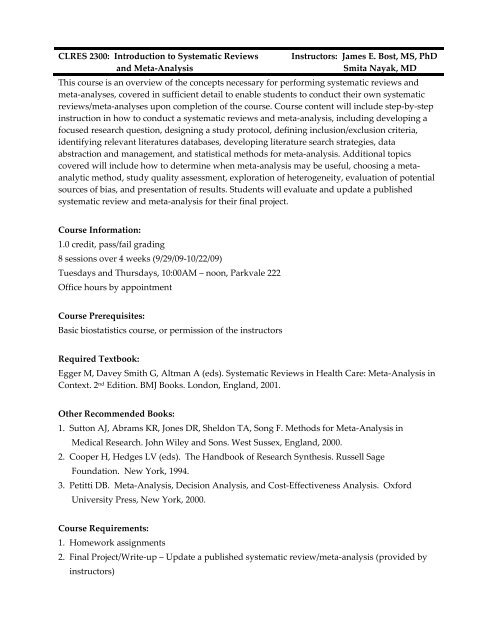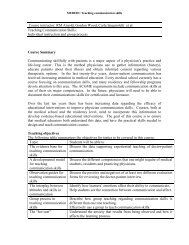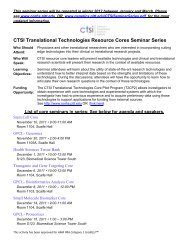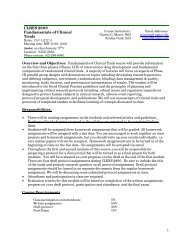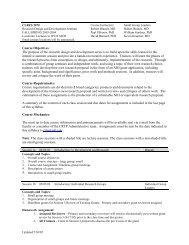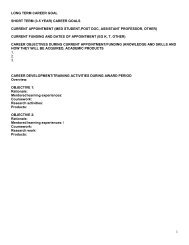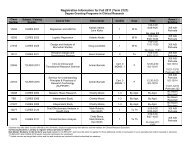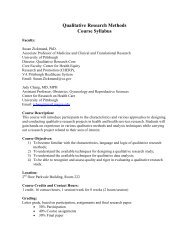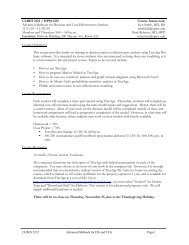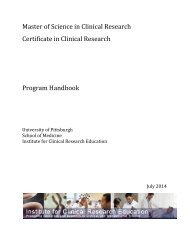CLRES 2300: Introduction to Systematic Reviews and Meta-Analysis ...
CLRES 2300: Introduction to Systematic Reviews and Meta-Analysis ...
CLRES 2300: Introduction to Systematic Reviews and Meta-Analysis ...
Create successful ePaper yourself
Turn your PDF publications into a flip-book with our unique Google optimized e-Paper software.
<strong>CLRES</strong> <strong>2300</strong>: <strong>Introduction</strong> <strong>to</strong> <strong>Systematic</strong> <strong>Reviews</strong><strong>and</strong> <strong>Meta</strong>‐<strong>Analysis</strong>Instruc<strong>to</strong>rs: James E. Bost, MS, PhDSmita Nayak, MDThis course is an overview of the concepts necessary for performing systematic reviews <strong>and</strong>meta‐analyses, covered in sufficient detail <strong>to</strong> enable students <strong>to</strong> conduct their own systematicreviews/meta‐analyses upon completion of the course. Course content will include step‐by‐stepinstruction in how <strong>to</strong> conduct a systematic reviews <strong>and</strong> meta‐analysis, including developing afocused research question, designing a study pro<strong>to</strong>col, defining inclusion/exclusion criteria,identifying relevant literatures databases, developing literature search strategies, dataabstraction <strong>and</strong> management, <strong>and</strong> statistical methods for meta‐analysis. Additional <strong>to</strong>picscovered will include how <strong>to</strong> determine when meta‐analysis may be useful, choosing a metaanalyticmethod, study quality assessment, exploration of heterogeneity, evaluation of potentialsources of bias, <strong>and</strong> presentation of results. Students will evaluate <strong>and</strong> update a publishedsystematic review <strong>and</strong> meta‐analysis for their final project.Course Information:1.0 credit, pass/fail grading8 sessions over 4 weeks (9/29/09‐10/22/09)Tuesdays <strong>and</strong> Thursdays, 10:00AM – noon, Parkvale 222Office hours by appointmentCourse Prerequisites:Basic biostatistics course, or permission of the instruc<strong>to</strong>rsRequired Textbook:Egger M, Davey Smith G, Altman A (eds). <strong>Systematic</strong> <strong>Reviews</strong> in Health Care: <strong>Meta</strong>‐<strong>Analysis</strong> inContext. 2 nd Edition. BMJ Books. London, Engl<strong>and</strong>, 2001.Other Recommended Books:1. Sut<strong>to</strong>n AJ, Abrams KR, Jones DR, Sheldon TA, Song F. Methods for <strong>Meta</strong>‐<strong>Analysis</strong> inMedical Research. John Wiley <strong>and</strong> Sons. West Sussex, Engl<strong>and</strong>, 2000.2. Cooper H, Hedges LV (eds). The H<strong>and</strong>book of Research Synthesis. Russell SageFoundation. New York, 1994.3. Petitti DB. <strong>Meta</strong>‐<strong>Analysis</strong>, Decision <strong>Analysis</strong>, <strong>and</strong> Cost‐Effectiveness <strong>Analysis</strong>. OxfordUniversity Press, New York, 2000.Course Requirements:1. Homework assignments2. Final Project/Write‐up – Update a published systematic review/meta‐analysis (provided byinstruc<strong>to</strong>rs)
Session 1Date9/29Background about systematic reviews/meta‐analysisFormulating a research question <strong>and</strong> study pro<strong>to</strong>colInstruc<strong>to</strong>r:NayakTopics:1. Definitions of systematic review <strong>and</strong> meta‐analysis2. Why do we need systematic reviews <strong>and</strong> meta‐analyses?3. Difference between systematic reviews <strong>and</strong> narrative reviews4. <strong>Systematic</strong> reviews/meta‐analysis of RCTs versus other study designs5. <strong>Introduction</strong> <strong>to</strong> the Cochrane Collaboration6. Outline of steps in performing a systematic review, including:• Defining a research question• Defining inclusion/exclusion criteria• Developing a study pro<strong>to</strong>colRequired Reading (prior <strong>to</strong> session):1. Egger Chapters 1, 2, 12, 252. Ross, et al. article (provided on CourseWeb)In‐class Exercise:Begin <strong>to</strong> draft a systematic review/meta‐analysis study pro<strong>to</strong>col based on the Ross, et al. articleyou will be updating for the course final project. Specifically: 1) refine the research question, ifnecessary; 2) specify inclusion <strong>and</strong> exclusion criteria; <strong>and</strong> 3) create an inclusion/exclusioncriteria form.Homework Assignment 1:Using the Ross, et al. article that we have chosen for the course project, review the researchquestion, pro<strong>to</strong>col, <strong>and</strong> inclusion/exclusion criteria listed in the article. Briefly answer thefollowing questions: Was the research question appropriately defined? Was it clear that aresearch pro<strong>to</strong>col was developed prior <strong>to</strong> initiation of the study? Was this pro<strong>to</strong>col explicitlystated? Were inclusion/exclusion criteria clearly stated? Is there anything that you might havedone differently regarding defining the research question, planning or presenting the studypro<strong>to</strong>col, or choice of inclusion/exclusion criteria? Additionally, create <strong>and</strong> h<strong>and</strong> in aninclusion/exclusion criteria form created using the same criteria stated by the study authors(continuation of in‐class exercise).Homework Assignment 1 due Thursday Oc<strong>to</strong>ber 1st
Session 2Date10/1Goals of literature searchHow <strong>to</strong> develop search strategies for online databasesInstruc<strong>to</strong>rs:Nayak,HSL LibrariansTopics:1. Goals of literature search2. Databases (MEDLINE, EMBASE, etc.) & database‐specific search strategies3. Designing & implementing database search strategies (with demonstration ofMEDLINE search)4. Searching the grey literature, h<strong>and</strong>searching journals, contacting experts <strong>to</strong> findadditional literature5. Underst<strong>and</strong>ing the Cochrane Collaboration <strong>and</strong> navigation of the Cochrane websiteRequired Reading (prior <strong>to</strong> session):1. Egger Chapter 42. Cooper Chapter 4Suggested Reading :1. Petitti Chapter 4In‐class Exercise:Experiment with the different MEDLINE search features learned in class <strong>to</strong>day (e.g., MESHterms, explode function) <strong>to</strong> identify search terms that can be used <strong>to</strong> find articles <strong>to</strong> update theRoss, et al. meta‐analysis. Begin <strong>to</strong> develop your own MEDLINE search strategy <strong>to</strong> update theRoss, et al. meta‐analysis.Homework Assignment 2:Review the search strategies indicated in the Ross, et al. meta‐analysis. Briefly answer thefollowing questions: Were the chosen databases appropriate <strong>to</strong> cover the relevant literature forthe research question? Would you have searched any additional databases? Were the searchstrategies for individual databases sufficiently broad <strong>to</strong> identify most of the literature on the<strong>to</strong>pic of interest within each of the databases? If there were limits placed on the search (e.g.language limits), were they appropriate? What steps (if any) were taken <strong>to</strong> find literaturebeyond the chosen databases? Additionally, design <strong>and</strong> h<strong>and</strong> in your own MEDLINE searchstrategy <strong>to</strong> identify articles <strong>to</strong> update this review (continuation of in‐class exercise).Homework Assignment 2 due Tuesday, Oc<strong>to</strong>ber 6thSession 3 Date Managing references Instruc<strong>to</strong>rs:
10/6 Applying inclusion/exclusion criteria <strong>to</strong> select articlesStudy quality assessmentAbstracting dataData managementHSL Librarians,NayakTopics:1. Managing <strong>and</strong> sharing references2. Applying inclusion/exclusion criteria <strong>to</strong> identify relevant articles3. Approaches <strong>to</strong> quality assessment4. Categories of data <strong>to</strong> abstract5. Data abstraction6. Data management/recordkeepingRequired Reading (prior <strong>to</strong> session):1. Egger Chapters 3, 5, 7Suggested Reading:1. Petitti Chapter 5In‐class Exercise:Begin <strong>to</strong> develop a data abstraction form <strong>to</strong> extract data from the articles you will find <strong>to</strong> updatethe Ross, et al. meta‐analysis. Use the data abstraction template provided in class <strong>to</strong>day <strong>to</strong>develop your own form.Homework Assignment 3:Complete <strong>and</strong> submit your data abstraction form <strong>to</strong> capture relevant information from articlesfound in your search <strong>to</strong> update the Ross, et al. meta‐analysis.Homework Assignment 3 due Thursday Oc<strong>to</strong>ber 8thSession 4 Date <strong>Introduction</strong> <strong>to</strong> Statistical Methods for <strong>Meta</strong>‐<strong>Analysis</strong> Instruc<strong>to</strong>r:
10/8 NayakTopics:1. How <strong>to</strong> determine if studies found in systematic reviews are appropriate for metaanalysis2. Statistical tests of homogeneity3. R<strong>and</strong>om effects versus fixed effects models4. Overview of commonly used meta‐analytic methods5. How <strong>to</strong> choose a meta‐analytic methodRequired Reading (prior <strong>to</strong> session):1. Egger Chapters 15, 162. Keren, et al. Article (provided on CourseWeb)Suggested Reading:2. Sut<strong>to</strong>n Chapters 3, 4 <strong>and</strong> 5In‐class Exercise:Using the STATA comm<strong>and</strong>s discussed in class <strong>to</strong>day, <strong>and</strong> the data set that we provided you,perform a statistical test of homogeneity <strong>and</strong> r<strong>and</strong>om <strong>and</strong> fixed effects meta‐analyses. Plot themeta‐analysis results using a forest plot.Homework Assignment 4:Using the list of articles found with the librarians’ search strategy (provided <strong>to</strong> you onCourseWeb), review the articles assigned <strong>to</strong> you <strong>to</strong> determine if any meet inclusion criteria. Usethe inclusion/exclusion criteria form that you created <strong>to</strong> identify additional articles. Keep arecord of <strong>to</strong>tal number of articles found in your search, the number of articles excluded, <strong>and</strong> thenumber <strong>and</strong> titles of articles that meet inclusion criteria. Using the data abstraction form provided <strong>to</strong>you by the class instruc<strong>to</strong>rs, abstract data from any studies that meet inclusion criteria. H<strong>and</strong> inthe data abstraction forms for the articles you found that meet inclusion criteria (if any).Additionally, h<strong>and</strong> in a brief write‐up summarizing how many of the titles/articles youreviewed were included vs. excluded, some of the most common reasons for exclusion, <strong>and</strong> thetitles of the articles that you found that met inclusion criteria.Homework Assignment 4 (last HW assignment) due Tuesday Oc<strong>to</strong>ber 13th
Session 5Date10/13Exploring dataInstruc<strong>to</strong>r:BostTopics:1. Publication bias <strong>and</strong> other potential sources of bias2. Overview of approaches <strong>to</strong> exploring heterogeneity3. Subgroup analysisRequired Reading (prior <strong>to</strong> session):1. Egger Chapters 8, 9, 11Suggested Reading:3. Sut<strong>to</strong>n Chapters 6 <strong>and</strong> 7In‐class Exercise:Using the STATA comm<strong>and</strong>s taught in class <strong>to</strong>day, <strong>and</strong> the dataset that we provide you,perform subgroup analysis <strong>and</strong> search for evidence of publication bias.Course Final Project:On Friday Oc<strong>to</strong>ber 16 th you will be provided with the dataset (both in Excel <strong>and</strong> Stata) <strong>and</strong> allthe Stata output needed for you <strong>to</strong> update the Ross, et al. meta‐analysis. Begin work on the finalproject write‐up, a no more than 10 page double‐spaced summary of your update of thepublished meta‐analysis. Your write‐up should be organized in<strong>to</strong> background (brief, no morethan one <strong>to</strong> two paragraphs), methods, results, <strong>and</strong> discussion sections. In addition <strong>to</strong>discussing what your conclusions are <strong>and</strong> whether they agree with Ross et al.’s conclusions inthe discussion section, also critique Ross, et al.’s methods. What did the authors do well? Whatmight you have done differently?Final Project due Friday November 6
Session 6Date10/15Exploring combined data, Part 2Instruc<strong>to</strong>r:BostTopics:1. Continuation of <strong>to</strong>pics covered in session 5 on Heterogeneity2. <strong>Meta</strong>‐Regression3. Assessing Study Quality4. Sensitivity analysisRequired Reading (prior <strong>to</strong> session):Egger Chapter 15 <strong>and</strong> 16Suggested Reading:4. Sut<strong>to</strong>n Chapters 8 <strong>and</strong> 9In‐class Exercise:Using the dataset that we provided you, perform meta‐regression, cumulative meta‐analysis<strong>and</strong> sensitivity analysis <strong>to</strong> evaluate the influence of individual studies on the meta‐analysisresults. Did removal of any of the individual studies significantly change the results?
Session 7DateLab: <strong>Meta</strong>‐<strong>Analysis</strong> using STATAInstruc<strong>to</strong>r:10/20BostTopics:1. Overview of STATA comm<strong>and</strong>s for meta‐analysis2. Step by step tu<strong>to</strong>rial using STATA <strong>to</strong> test for homogeneity, combine data, performsensitivity analysis, explore for evidence of publication bias, present resultsRequired Reading (prior <strong>to</strong> session):1. Egger Chapter 182. Chan, et al. article (provided on CourseWeb)In‐class Exercise:Step by step tu<strong>to</strong>rial of how <strong>to</strong> analyze your data in STATA.
Session 8Date10/22Applications of systematic reviews/meta‐analysisInstruc<strong>to</strong>rs:Nayak <strong>and</strong>BostTopics:1. Writing the <strong>Meta</strong>‐<strong>Analysis</strong> Report2. Brief <strong>Introduction</strong> <strong>to</strong> Other Contexts for <strong>Meta</strong>‐<strong>Analysis</strong>Required Reading (prior <strong>to</strong> session):Egger Chapters 19,21,22,23Suggested Reading:5. Sut<strong>to</strong>n Chapter 10In‐class Exercise:Time will be available <strong>to</strong> consult with your instruc<strong>to</strong>rs on the course final project.Course Final Project:Submit a no more than 10 page double‐spaced summary of your update of the published metaanalysis.Your write‐up should be organized in<strong>to</strong> background (brief, no more than one <strong>to</strong> twoparagraphs), methods, results, <strong>and</strong> discussion sections. In addition <strong>to</strong> discussing what yourconclusions are <strong>and</strong> whether they agree with Ross et al.’s conclusions in the discussion section,also critique Ross, et al.’s methods. What did the authors do well? What might you have donedifferently?Final Project Write‐up due Friday November 6 th .


